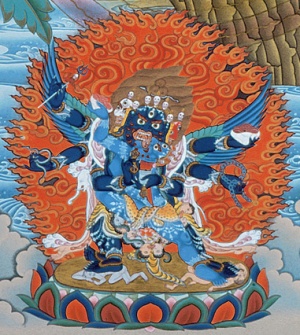Difference between revisions of "Yangdak Heruka"
| Line 4: | Line 4: | ||
| − | '''[[Yangdak Heruka]]''' ([[Wyl.]] ''[[yang dag heruka]]'') or '''[[Vishuddha]]''' (Skt. ''[[Viśuddhaheruka]]'') is one of the eight deities of [[Kagyé]], where he corresponds to Enlightened Mind. The wrathful manifestation of [[Vajrasattva]], he is similar to the deity known as [[Chakrasamvara]] (Tib. ''[[Demchok]]''), who is practised in the [[Gelug]] tradition. It is said that all the deities of the [[Mother Tantras]] are included in the practice of [[Yangdak]]. | + | '''[[Yangdak Heruka]]''' ([[Wyl.]] ''[[yang dag heruka]]'') or '''[[Vishuddha]]''' (Skt. ''[[Viśuddhaheruka]]'') is one of the eight deities of [[Kagyé]], where he corresponds to Enlightened Mind. The wrathful manifestation of [[Vajrasattva]], he is similar to the deity known as [[Chakrasamvara]] (Tib. ''[[Demchok]]''), who is practised in the [[Gelug]] tradition. It is said that all the [[deities]] of the [[Mother Tantras]] are included in the practice of [[Yangdak]]. |
The instructions related to [[Yangdak]] are based on the so-called "eight syllables of the ''rulu'' mantra".<ref>{{Nolinking|See Kongtrul (2005), pp. 322-323}}</ref> | The instructions related to [[Yangdak]] are based on the so-called "eight syllables of the ''rulu'' mantra".<ref>{{Nolinking|See Kongtrul (2005), pp. 322-323}}</ref> | ||
| − | In the [[Longchen Nyingtik]], the [[Yangdak]] | + | In the [[Longchen Nyingtik]], the [[Yangdak practice]] related to [[Palchen Düpa]] is called "[[Union Of The Buddhas]]" (''[[yang dag sangs rgyas mnyam sbyor]]''). |
| + | |||
==A Note on the Name== | ==A Note on the Name== | ||
| + | |||
''[[Yangdak Heruka]]'' is often translated back into [[Sanskrit]] as ''[[Vishuddha Heruka]]''. The [[Sanskrit]] term ''[[Vishuddha]]'' means ''[[pure]]'' and is usually rendered by [[Tibetans]] as ''[[Namdak]]'' (Wyl. ''[[rnam dag]]''). The [[Tibetan]] term ''[[Yangdak]]'', however in [[Sanskrit]] usually translates: | ''[[Yangdak Heruka]]'' is often translated back into [[Sanskrit]] as ''[[Vishuddha Heruka]]''. The [[Sanskrit]] term ''[[Vishuddha]]'' means ''[[pure]]'' and is usually rendered by [[Tibetans]] as ''[[Namdak]]'' (Wyl. ''[[rnam dag]]''). The [[Tibetan]] term ''[[Yangdak]]'', however in [[Sanskrit]] usually translates: | ||
| Line 19: | Line 21: | ||
c) an adjective or an epithet, such as ''[[shri]]''. | c) an adjective or an epithet, such as ''[[shri]]''. | ||
</poem> | </poem> | ||
| + | |||
[[Humkara]] wrote three [[sadhana]]s preserved in the [[Tibetan]] [[Tengyur]] dedicated to [[Shri Heruka]] (D 1674, D 1675 & D 1678). One of these [[sadhanas]] (D 1678) was translated into [[Tibetan]] by [[Namkhé Nyingpo]]. The title of this [[sadhana]] contains ''[[Yangdak]]'', and it is dedicated to ''[[Shri Heruka]]'' (Wyl. ''[[dpal khrag 'thung]]''). Although this may not be a conclusive argument, it suggests that the name of ''[[Yangdak Heruka]]'' in [[Sanskrit]] is ''[[Shri Heruka]]''. Another possibility, which may speak in favour of ''[[Vishuddha Heruka]]'' is that ''[[Shri]]'' means ''glorious'' and is an epithet used for many deities. This would imply that the deity is simply referred to as ''[[Glorious Heruka]]'', while its actual name is different. | [[Humkara]] wrote three [[sadhana]]s preserved in the [[Tibetan]] [[Tengyur]] dedicated to [[Shri Heruka]] (D 1674, D 1675 & D 1678). One of these [[sadhanas]] (D 1678) was translated into [[Tibetan]] by [[Namkhé Nyingpo]]. The title of this [[sadhana]] contains ''[[Yangdak]]'', and it is dedicated to ''[[Shri Heruka]]'' (Wyl. ''[[dpal khrag 'thung]]''). Although this may not be a conclusive argument, it suggests that the name of ''[[Yangdak Heruka]]'' in [[Sanskrit]] is ''[[Shri Heruka]]''. Another possibility, which may speak in favour of ''[[Vishuddha Heruka]]'' is that ''[[Shri]]'' means ''glorious'' and is an epithet used for many deities. This would imply that the deity is simply referred to as ''[[Glorious Heruka]]'', while its actual name is different. | ||
Latest revision as of 07:55, 6 September 2018

Yangdak Heruka (Wyl. yang dag heruka) or Vishuddha (Skt. Viśuddhaheruka) is one of the eight deities of Kagyé, where he corresponds to Enlightened Mind. The wrathful manifestation of Vajrasattva, he is similar to the deity known as Chakrasamvara (Tib. Demchok), who is practised in the Gelug tradition. It is said that all the deities of the Mother Tantras are included in the practice of Yangdak.
The instructions related to Yangdak are based on the so-called "eight syllables of the rulu mantra".[1]
In the Longchen Nyingtik, the Yangdak practice related to Palchen Düpa is called "Union Of The Buddhas" (yang dag sangs rgyas mnyam sbyor).
A Note on the Name
Yangdak Heruka is often translated back into Sanskrit as Vishuddha Heruka. The Sanskrit term Vishuddha means pure and is usually rendered by Tibetans as Namdak (Wyl. rnam dag). The Tibetan term Yangdak, however in Sanskrit usually translates:
a) an upsarga like sam,
b) an adverb like samyak (Eng. perfect, total, complete), or
c) an adjective or an epithet, such as shri.
Humkara wrote three sadhanas preserved in the Tibetan Tengyur dedicated to Shri Heruka (D 1674, D 1675 & D 1678). One of these sadhanas (D 1678) was translated into Tibetan by Namkhé Nyingpo. The title of this sadhana contains Yangdak, and it is dedicated to Shri Heruka (Wyl. dpal khrag 'thung). Although this may not be a conclusive argument, it suggests that the name of Yangdak Heruka in Sanskrit is Shri Heruka. Another possibility, which may speak in favour of Vishuddha Heruka is that Shri means glorious and is an epithet used for many deities. This would imply that the deity is simply referred to as Glorious Heruka, while its actual name is different.
Footnotes
- ↑ See Kongtrul (2005), pp. 322-323
Further Reading
- Jamgön Kongtrul Lodrö Tayé, The Treasury of Knowledge: Systems of Buddhist Tantra, Ithaca: Snow Lion, 2005